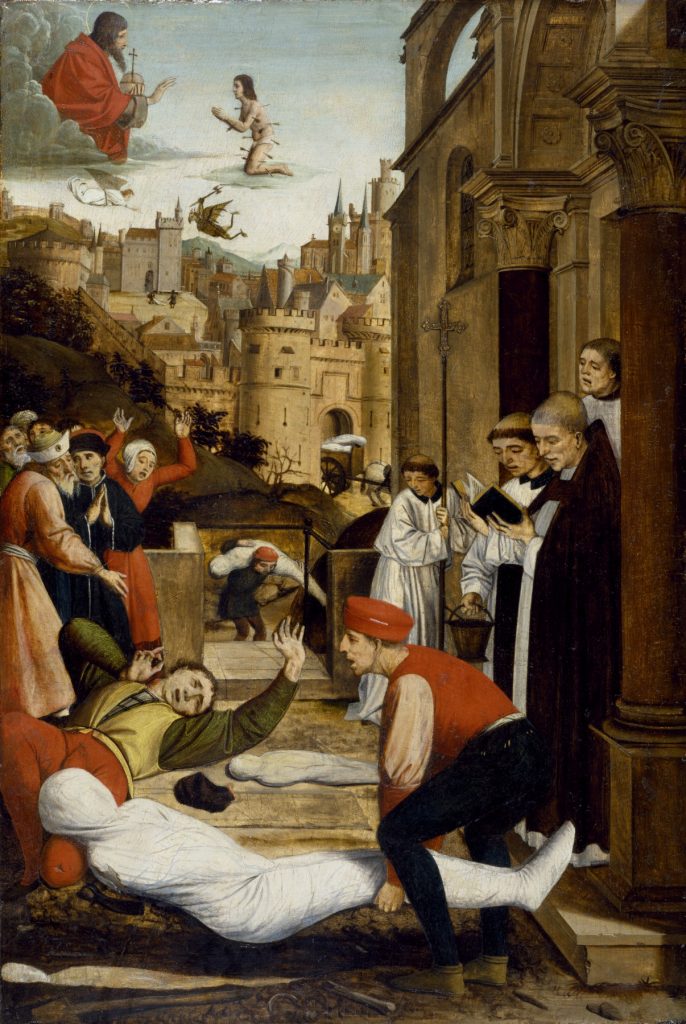There have been many epidemics that have plagued our planet over the last few thousand years; some, however, were more devastating than others. Epidemics often cause major disruptions in a society, besides simply killing people. They affect the amount of people in the workforce, which in turn can disrupt the production of goods and the food supply needed for a society.
The famous Bubonic Plague killed around a third of the population of Europe in the 1300s. The population of Europe in 1340 was about 73.5 million, and the plague affected over 20 million people. Today, Europe’s population is 508,450,856, meaning that if the plague were to have the same effects today as it did in the 1300s, it would kill around 102,000,000 people!1

The Bubonic Plague originated in the fleas carried by rodents like rats, squirrels, and prairie dogs, which transmitted the disease from one to the other. The disease spread from southwestern China to eventually the Black Sea ports of Caffa and Tana by 1346, and by 1348 it had reached northern Europe.2 The disease caused about the same symptoms in all of its victims, such as a fever, and pain so strong that they were not able to keep down any food. The name of this disease came from the fact that the people would become covered in black boils that oozed puss and blood.3 The photograph to the right is an exhibit at the Eyam Museum showing what an infected person would have looked like. The disease was highly contagious and was deadly because it worked so quickly; its victims could have been healthy one day and gone the next.

This image is of a doctor’s mask, which is similar to the masks that doctors used during the plague. These masks were believed to have protected them from breathing in the infected air. However, the masks were not very effective since many doctors contracted the disease.
This epidemic did not affect European countries in just one way, it caused major problems in many aspects of life for many areas. The continent had been battling famine and food shortages before the plague struck; then afterwards it left them in an even more compromising situation. There was a shortage of workers in the workforce, which meant that all aspects of production were affected, from food to goods and services. Try to imagine one third of the people you connect with on a regular basis completely gone. That would be a third of all the doctors, the workers you’ve encountered at the grocery store, a third of all the teachers, and even a third of one’s entire family. While this is happening, one’s entire country might already be going through a devastating famine. It is incredible that Europe was able to recover from this disaster and now has one of the largest populations in the world. The continent was able to recover from losing over a third of its population, in one of the most notorious epidemics in our world’s history, and now thrives as a largely populated and diverse part of the world.
- Josiah C. Russell, The Fontana Economic History of Europe, Vol. I: The Middle Ages, “Population in Europe,” (HarperCollins Distribution Services, 1972); European Union, “Living in the EU,” Europa.eu. (accessed November 2, 2016), http://europa.eu/european-union/about-eu/figures/living_en#tab-1-3. ↵
- Jerry H. Bentley, Herbert F. Ziegler, and Heather E. Streets-Salter, Traditions and Encounters: A Brief Global History Volume 1. 4th ed. Vol. 1. (McGraw Hill Education, 2016), 333-336. ↵
- McClain, Charles. “Of Medicine, Race, and American Law: The Bubonic Plague Outbreak of 1900,” Law & Social Inquiry 13, no. 3 (1988): 447-513. ↵



58 comments
Samman Tyata
I found the article really well managed and informative. Honestly, this is the first time I heard about the Bubonic Plague and it’s really upsetting to know that it wiped out one-third of the European population. It’s really insane that the disease killed people over the course of one day. Apart from that, I was very glad to read that the continent was able to recover from such a huge loss. Well done, it was a great read.
Megan Barnett
Well written article I also think your pictures matched very well and for sure set the mood of your story. I liked how you related this past epidemic to our lives today because it really helped me as the reader understand what was going on during the Bubonic plague. It is very surprising that such a thing could cause so much destruction, but you are right that it was a miracle that Europe was able to recover from it.
Mariana Govea
Great article!! What an unfortunate and ugly plague!! It killed many innocent people!!And its crazy to read about it now since living in the 21st century we take advantage of the medical advancement that we have here today!! Even though the plague almost wiped out Europe they were able to get back on their feet and recover from it which is amazing!! Because if they were able to recover from that they can probably recover from anything else since this was definitely one of the worst for Europe and its people since it affected everyone who came across it!
Cesar Zavala
I learned about the Bubonic Plague in the early years of my education and had heard the horrible tales on how life was for the people who were living through this epidemic straight out of a horror movie. It crazy to think that something similar to this could happen, hopefully due to our advancement in medicine and emergency protocols, the amount of people affected would be not as significant as it was with the
Bubonic Plague. Great article!
Alyssa Valdez
I thought that this article was very interesting and honestly a bit scary to think about! Just imagining that the Bubonic plague could wipe out almost a 3rd of the population is absolutely crazy! It is so unfortunate that so many lives were taken without any chance! thankfully they were able to recover. Anyways, I thought your article was very interesting and very informative! great read
Johnanthony Hernandez
Interesting article and this may sound a bit morbid but I have always been interested in the Bubonic plague. Not necessarily the death but in how quickly the virus worked. Not many viruses can kill a healthy human in such a quick time or spread as quickly as it did with the means of transportation. It makes me think that if we were to have another large scale outbreak of the plague today, I say large scale because the virus is still killing people in small amounts, with the means of transportation we have now. Would a third of the total population, not just on area, be wiped out from it? Again, interesting article and great work.
Steven Clinton
Interesting article, the bubonic plague wipe out one-third of the European population. I don’t most people realize the magnitude of the amount of destruction the league cost. In the article, it says the epidemic not only harm the people but the overall productivity of the country. It goes without saying that the economies of the European countries tanked. Great article!
Ana Gonzalez
Interesting article! The effects of the Bubonic Plague sound terrifying and disturbing, I can’t even imagine the pain of having huge, black and painful blisters in my body. Plagues like these always affect all aspects of society and you did a good job explaining so. I also thought it was cool how you added a picture of the doctors’ masks and explained that despite these innovations, the Bubonic Plague could not be contained. Well done, it was a great read.
Mario De Leon
This was an interesting read. I liked how the author pointed out that an epidemic not only kill people but harm society as well like the workflow or the production of goods. I enjoyed looking at the mask that the doctors would use and found it interesting that I wasn’t useful since a lot of doctors still got the disease.
Marissa Gonzalez
This is so devastating on how much damage the Bubonic Plague did to the European population. I cannot imagine losing a third of the population around me and I also cannot imagine living in a time like that. It is a blessing that the doctors would risk their lives to help those infected with the disease even though some of them became infected as well. This is why I feel that being sanitary is very important for everyone’s health and well being. You did a great job in including how the population would be affected today if the plague was occurring. Well done and very informative!